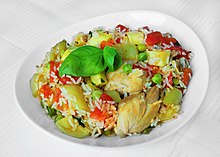Parboiled rice
[5][6] Given the pale tan color that results from these bran components, parboiled rice is sometimes called saffron sella.
Cooling brings retrogradation whereby amylose molecules re-associate with each other and form a tightly packed structure.
This increases the formation of type-3, resistant starch which can act as a prebiotic and benefit health in humans.
In North America parboiled rice is often partially or fully precooked before sale.
[10] In older methods, clean paddy rice was soaked in cold water for 36–38 hours to give it a moisture content of 30–35%, after which the rice was put in parboiling equipment with fresh cold water and boiled until it began to split.
[15] Other variations on parboiling include high-pressure steaming and various ways of drying (dry-heat, vacuum, etc.



